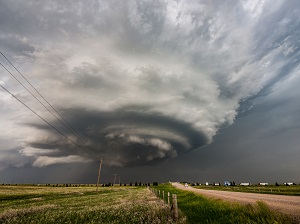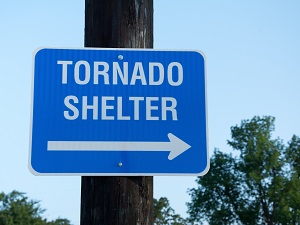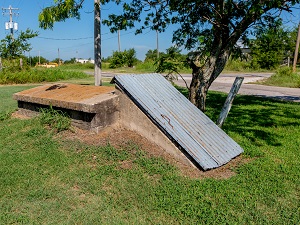Workers in many areas know that tornadoes can be a possibility, especially at certain times of the year. Businesses, construction sites, and workers should be prepared before a tornado becomes threatening, know the best ways to stay safe if a tornado gets close, and understand the hazards that workers may face in the aftermath of a tornado.

While the majority of tornadoes occur in the Great Plains of the central United States, also referred to as “Tornado Alley”, tornadoes can occur and have been reported in all 50 states.
Depending on the area, peak tornado “season” is spring through summer, but it’s important to remember that tornadoes can occur at any time of year. Tornadoes can happen at any time of day or night, but most tornadoes occur between 4-9pm.
Tornadoes can occur with little or no warning. To ensure everyone stays safe if a tornado occurs in the area workers can take precautionary actions, including:
- Review and understand the emergency action plan
- Actively participate in emergency drills
- Know the on-site shelter-in-place location
- Learn the warning signs of a tornado
- Pay attention to news of thunderstorms
- Review response and recovery plans
OSHA Construction Standard 1926.35(e)(3) The written plan shall be kept at the workplace and made available for employee review. For those employers with 10 or fewer employees the plan may be communicated orally to employees and the employer need not maintain a written plan.
Workers need to be trained and plans need to be practiced to ensure that personnel are familiar with what to do in the event of a tornado. Though Emergency Action Plans primarily involve evacuations, emergency planning for tornadoes involve identifying safe places of refuge for workers to go to in the event of tornadoes.

Tornadoes often accompany thunderstorms. When there are thunderstorms in the area, stay tuned to the local news or a reliable weather app on your phone for alerts. Pay close attention to changing weather conditions when there is a severe thunderstorm watch or warning. Workers should be prepared to take shelter immediately if conditions worsen.
OSHA General Industry Standard 1910.38(b) An emergency action plan must be in writing, kept in the workplace, and available to employees for review. However, an employer with 10 or fewer employees may communicate the plan orally to employees.
Some tornadoes develop quickly and allow no time for a tornado warning, so it is important for workers to know the signs of a tornado, which may include:
- Dark, often greenish clouds or sky
- Large, dark, low-lying cloud
- Approaching cloud of debris
- Large hail
- Rotating funnel-shaped cloud
- Roaring noise
A tornado watch means that Tornadoes are likely to occur in the watch area. Keep an eye on the weather report, listen for the local tornado warning system, confirm the location of the tornado shelter area for workers, and be ready to act quickly.
A tornado warning is more serious and means that a tornado has been sighted in the area or has been indicated by radar. Everyone in the area should take shelter immediately!

All workers should be familiar with the designated tornado shelter location at the worksite. An underground area, like a basement or storm cellar, provides the best protection from a tornado. If an underground shelter is unavailable seek a small interior room or hallway on the lowest floor.
Most injuries and fatalities are caused by falling objects and flying debris. Stay away from doors, windows, and outside walls. If there isn’t time to get to a tornado shelter or to a lower level, try to get under a door frame or get up against something that will support or deflect falling debris.
Avoid auditoriums, cafeterias, or other enormous rooms that have flat, wide-span roofs. These large open rooms are especially dangerous because the roof is usually only supported by the outside walls and the pressure from a tornado will cause them to collapse.
Avoid taking shelter where heavy objects and machinery are on the floor directly above you. These could fall through the floor if the tornado strikes the building. For added protection, get under something sturdy like a work bench. If possible, cover your body and protect your head.

Personnel should be aware of what to do if caught outdoors when a tornado is threatening. Seek shelter in a basement or a sturdy building. If one is not within walking distance, try to drive in a vehicle, using a seat belt, to the nearest shelter.
If driving, do not try to outrun a tornado. If flying debris is encountered while in a vehicle, and you are unable to make it to a safe shelter, there are two options:
1. Stay in the vehicle with the seat belt on, keep your head below the windows, and cover your head and neck with your hands or a blanket.
2. If there is an area which is noticeably lower than the roadway, like a ditch or a ravine, lie in that area and cover your head with your hands.

Response and recovery work after a tornado presents safety hazards that should be properly identified, evaluated, and controlled to reduce or eliminate risks to workers. Hazards may include:
- Hazardous driving conditions
- Slips and falls
- Falling objects like tree limbs and utility poles
- Sharp objects including nails and broken glass
- Electrical hazards from downed power lines
- Fires caused by energized line contact or equipment failure
- Exhaustion, heat stress, and dehydration
There are some general safety precautions to consider after a tornado, or any similar disaster. Do not attempt to move seriously injured people unless they are in immediate danger of further injury. Get medical assistance immediately.
Wear proper clothing when walking on or near debris, including boots and gloves. Take all proper safety measures when operating generators, chainsaws, or any other power tools.
If structural, electrical, or gas-leak hazards are identified, work with your supervisor to notify the proper local authorities. Some operations, such as utility restoration, cleaning up spills of hazardous materials, and search and rescue, should only be conducted by workers who have the proper training, equipment, and experience.


